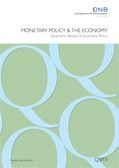Monetary Policy and the Economy Q4/17
 OeNB
OeNB
- published:
- December 2017
 OeNB
OeNB
Monetary Policy and the Economy Q4/17 (PDF, 1.2 MB) December 2017
Call for applications: Visiting Research Program (PDF, 45 kB) en Dec 31, 2017, 12:00:00 AM
Austria's thriving economy is fueled by lively exports and strong domestic demand (PDF, 624 kB) Fenz, Schneider. Economic outlook for Austria from 2017 to 2020 en Dec 31, 2017, 12:00:00 AM
Three small essays on public investment: economic rationales, the EU fiscal framework and some statistical comparisons (PDF, 409 kB) Prammer, Reiss. Governments undertake public investments for a number of reasons. First, spending on public investment is a means to foster economic growth, in the short run by increasing aggregate demand and in the long run by (potentially) increasing growth potential. Second, public investments can be justified by the presence of market failures. And finally, they can be undertaken due to fairness objectives. Given the growth-enhancing impact of public investment expenditure, the EU has taken several initiatives to increase the low and, during the crisis, falling level of public investment in the EU. Most prominently, an investment clause was introduced into the Stability and Growth Pact (SGP), and the Investment Plan for Europe was launched. This can be considered an (albeit imperfect) substitute for the “golden rule” advocated by its proponents since the launch of the SGP. The ratio of government investment in Austria, at about 3% of GDP, is relatively far above that of Germany (around 2% of GDP), and has recently surpassed the euro area average. However, these figures are somewhat distorted by different sector classifications in the areas of transport, hospitals and municipal services. en public investment, fiscal rules E22, H54 Dec 31, 2017, 12:00:00 AM
Household's housing expenditure in Austria, Germany and Italy (PDF, 354 kB) Beer, Wagner. For many households, housing-related expenditures make up a substantial share of total consumption. This article aims to shed some light on households’ current housing expenses in Austria, Germany and Italy. To this end, we use national data from the 2014 Household Finance and Consumption Survey (HFCS) to calculate the current housing expenditure (the ratio of current housing expenses to household net income). Comparing these three countries we see that the housing expenditure is lowest in Italy, with an average (mean) of 22% (median: 17%), and highest in Germany (mean: 37%, median: 31%). The average housing expenditure in Austria is 29% (median: 26%). In all three countries, the housing expenditure decreases as income and/or wealth increases. The current housing expenditure of tenants is higher than that of homeowners. On average, homeowners’ housing expenditure amounts to 21% in Austria, 31% in Germany and 19% in Italy, whereas the average housing expenditure of tenants is 39% in Austria, 44% in Germany and 36% in Italy. In particular, homeowners without outstanding housing loans have a relatively low current housing expenditure. The difference between the median current housing expenditure of indebted owners and that of owners without debt is 10% in Austria, 17% in Germany and 19% in Italy. Differences across surveys still make international comparisons of housing expenses difficult. However, the availability of HFCS data has improved the situation considerably. en housing costs, housing expenditures, housing finance D14, D31, R21, R38 Dec 31, 2017, 12:00:00 AM